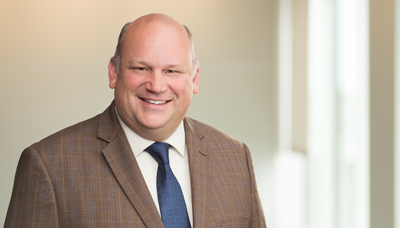Greg Cooper, a patent attorney in Barnes & Thornburg LLP's Fort Wayne, Indiana office and a member of the firm's Intellectual Property Law Department, authored the column, "Improving wiring in cables," for the May 23, 2011 edition of the Fort Wayne Journal-Gazette. Greg's column, "Patently Speaking," highlights various patents issued by the U.S. Patent and Trademark Office.
Greg is an attorney in Fort Wayne, Indiana practicing in the areas of patent, trademark, copyright, procurement, and litigation in the U.S. and internationally. He can be reached at gcooper@btlaw.com or (260) 425-4660.
A copy of Greg's article for the week of May 23, 2011 appears below.
PATENTLY SPEAKING
May 23, 2011
Patently Speaking highlights the technological achievements of Fort Wayne area residents.
APPARATUS AND METHOD OF ROUTING CABLING AROUND LEVELER LEGS IN A THIN MODULAR OFFICE PANEL
U.S. Patent No. 7,926,231
Invented by: Gregg E. Laukhuf, Bryan, OH
Assigned to: Group Dekko, Inc., Kendallville, IN
Technology has a tendency of making things smaller and thinner while still accomplishing the same task. Whether comparing today’s computers with those of 25 years ago, or even Apple’s iPhone with Motorola’s portable phone from the eighties, it is undeniable how technological advancement makes these things smaller, thinner, and better.
Believe it or not, the same can be said for office cubicle partitions. Of course, cubical partitions have been around for a long time, but now they are much thinner. There is no more need for the bulk of the prior thicker partitions from the past to achieve the same sturdy structure.
A downside to these thinner partitions is it is more difficult to run wiring between them. Despite the thinner cubicles walls, the power requirements and the various cords needed for a typical office space has only increased. This causes a problem because regardless of how thin cubicle walls become, power lines, telephone wires, and networking cables are still needed, and there is no desire for any of these wires to be exposed in the office space.
One issue with wiring thin cubical walls is connecting the wires from one cubicle section to another.
This patent tackles the problem by running the wires along the base of the panels. Typically, these panels have leveler legs which include flat pads attached to a threaded screw that rotates in and out of the bottom of the partition. Because the screw is thinner than the pad, a jumper cable can be positioned next to the screw to connect to cables of an adjoining partition without being noticed.
EXPANDABLE PROXIMAL REAMER
U.S. Patent No. 7,935,117
Invented by Samuel G. Sackett, Fort Wayne, IN; Jonathan E. Carr, Warsaw, IN; and Larry G. McCleary, Warsaw, IN
Assigned to: Depuy Products, Inc., Warsaw, IN
This patent is directed to a surgical tool used in joint replacement surgery, otherwise known as joint arthroplasty.
Called a reamer, this tool helps rout out conically shaped portions of bone, such as the femur, so the stem of an artificial joint, such as a hip, can fit into the bone. Reamers bore holes into the bone.
As can be imagined, fitting the right size artificial joint is a bit tricky. Depending on the size of the person, the joints may be larger or smaller. As a consequence, the reamer needs to bore sometimes wider or sometimes thinner holes in the bone.
This patent describes a reamer that has an adjustable cutting blade. The blade may expand or contract for cutting larger or narrower holes. Rather than using multiple reamers, this single reamer allows the surgeon to simply turn a knob that is attached to gears that adjust the cutting blade’s diameter.
The preceding are lay descriptions of patents obtained from the United States Patent and Trademark Office’s public records and are provided for general information purposes only. Nothing contained herein is a legal description of any claimed invention, identification of novelty, or offer of legal advice. Because issued patents are based on applications often filed years earlier, the subject matter of some patents may have been available on the market for some time prior to the issuance of the patent. Additional information on these patents is available at www.uspto.gov.














